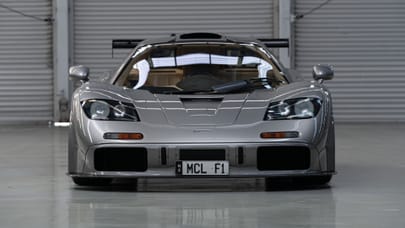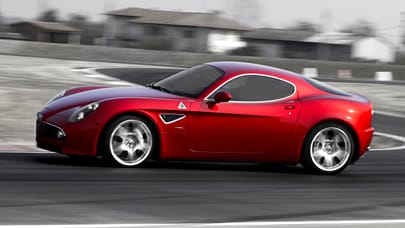

In 1988's seminal anime film Akira, the perversion of protagonist Tetsuo's psychic powers and subsequent tyranny force his kin to summon the spirit of the film's namesake: a supreme psychic child whose reappearance causes another ‘big bang', such is his power.
Well, starting up the Fiat SB4 - or Mephistopheles - will likely cause a similar reaction. The picture above gives no credence or authority to the sheer Judgement Day violence the Fiat's engine brings. I'm standing on a secluded straight at Fiat's technical research centre in Balocco and the SB4 is alive. We're talking End of Days, Apocalypse, Old Testament style fury. It's loud.
Words: Vijay Pattni
Photos: Michael Ward/FiatAdvertisement - Page continues below
The reason for its preposterous, Neolithic volume can be traced back to the car's roots, and a fascinating story about an Englishman who liked going very fast indeed. A pre-war speed demon with as much regard for personal safety as Jeremy has for the Toyota Prius.
In 1922, a man named John Duff was competing at Brooklands in a 1908 Fiat SB4; a Fiat SB4 with both eyes fixed firmly on collecting its retirement pension. History will tell you the Fiat suffered a breakdown at Brooklands forcing Duff to retire and the Fiat to rethink its life. Legend will tell you the 18-litre engine suffered a catastrophic failure as one of the cylinder blocks exploded, headed for space and took some bonnet with it.

Step forward our protagonist and speed-demon, Sir Ernest Eldridge. He bought the scrap remains of the Fiat following Duff's fiery exit, and rather than repair the existing 18-litre behemoth, instantly (and correctly) decided more was needed. He fixed his mind on sourcing an aircraft engine for the SB4, and settled on Fiat's A.12: a straight-six, single-cam unit with a capacity of 2,1706cc.
To give you some context, this straight-six was used in Italian reconnaissance and bomber aircraft, providing a suitably thunderous heart for Eldridge's speedy plans.
Advertisement - Page continues below
Eldridge used elements of a London bus to lengthen the Fiat SB4's chassis because the 320bhp A.12 was too long to fit under the bonnet. It did however, have the pleasing effect of making the Fiat look rather streamlined and almost elegant; a far cry from its almost garden-shed mechanicals. It had a double-chain transmission and brakes that acted on the rear diff rather than the wheels, a process of deceleration that we will come to later.

Satisfied that the ol' girl was safe to hit some serious speed, Ernest and his team decamped to France in Arpajon in 1924 to compete against Rene Thomas and his Delage V12 (packing 350bhp) for the land speed record. Ernest rocked up to the start line and began the arduous task of firing up the Fiat SB4. And it's here we take our story back to the future...

It will come as no surprise to you that the SB4 requires a more complicated start-up procedure than jumping in via keyless entry and pressing a big red starter button. Or indeed, cranking a starter motor with a key.
Fiat's stubby-fingered agent of SB4 engineering, Gianfranco Dazia, needs around 20 minutes to prep the speed-demon into life. First, he sponges the engine down with soapy water "to stop it exploding into a ball of flames", before adding small drops of fuel into the carburettors and lining up the pistons into a precise position.

He then takes a massive wrench, cranks the whole engine over and... at this point I'm advised to stand back and prepare for ‘something a bit loud'. It's not ‘something', it's ‘oh-my-god-the-world-is-going-to-end'. Gianfranco turns over the engine - removing the wrench quickly before it takes him and his arm skywards - and it sounds like World War 2. The Fiat thunders into life accompanied by a plume of black smoke, the roar of six gargantuan pistons burning much fuel, and some astonished jaws on the floor. Gingerly, I am asked to get in quickly before it overheats (it needs a fast straight run to cool it down sufficiently) for a passenger ride.
Advertisement - Page continues below
It accelerates as you would expect, which is to say, ‘ruddy fast'. The increments arrive in quickened gasps, each more brutal than the last. With an unquantifiable but presumably huge torque figure, the rear wheels even step out of line as the test driver, Michael Terlizzi, guns the throttle and rockets down the straight. The Fiat spits out oil, water and unspecified gunk in my face, and we approach the end (a short grass run-off with a concrete end) with Michael smiling and proclaiming in broken English, "no brakes".

It's intense. It uses four spark plugs per cylinder - because the piston surface area is so massive - weighs 1,800kg, drinks 16kg of oil for the engine, 8kg of oil for the gearbox and uses one litre of fuel for every 500m. It also rides on paper-thin 23s up front and 33in wheels at the back. No wonder Eldridge ‘weaved dangerously' on his first run...
Advertisement - Page continues below
Step back into 1924. Eldridge installs a very basic reverse mechanism for his SB4 to comply with the speed record regulations after an initial 143.26mph run (which Thomas' Delage had already eclipsed with a 143.31mph record). But Ernest returned on 12 July, laid down a scorching time of 146.01mph and promptly blew the competition into the winds. The French press, upon hearing the Fiat thunder through the French commune of Arpajon, immediately nicknamed his car ‘Mephistopheles', the fabled demon from Christopher Marlowe's classic play. It's easy to see why.
To read more about Mefistofele, buy the July issue of TopGear magazine, on sale now, which comes with a free supplement on our 150 greatest Italian cars of all time.
Trending this week
- Car Review
BMW 1 Series







